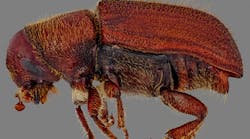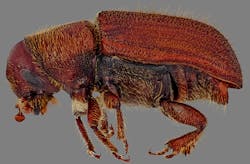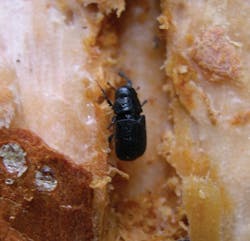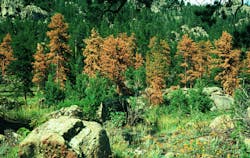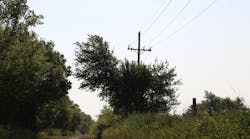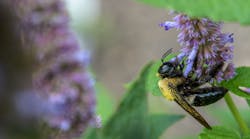In British Columbia, Alberta, Canada, a team led by the British Columbia Ministry of Forests, Lands and Natural Resource Operations produces province-wide projections of a mountain pine beetle outbreak. These projections are based on information produced by a provincial-level mountain pine beetle model, which uses forest cover maps, the provincial aerial overview surveys of forest health, and information from a mountain pine beetle population model. The projections estimate the current extent of pine mortality and project a possible course of the infestation into the future.
Beetle Description and Biology
The mountain pine beetle (Dendroctonus ponderosae) extends throughout the pine forests of the British Columbia, the Western United States and northern Mexico. It typically infests mature forests and primarily attacks lodgepole pine (Pinus contorta), but may also attack ponderosa (Pinus ponderosae), western white pine (Pinus monticola), whitebark pine (Pinus albi- caulis) and sugar pine (Pinus lambertiana).
Attacked trees are usually a minimum of 15 cm (6 inches) in diameter and mature, greater than 80 years old, Although beetles have been observed to attack younger trees during epidemics, survival of the beetle in these larger trees is better because of the thickness of the bark.
Outbreaks of mountain pine beetle are capable of killing millions of trees over thousands of hectares (acres) with the right forest stand and environmental conditions. Once beetles reach epidemic levels, they are more capable of overcoming a tree’s resistance.
Adult beetles introduce blue-stain fungi into the sapwood, which interrupts the flow of water to the crown and decreases the tree’s ability to produce resin. The combination of beetles and fungi cause the tree to die, usually within one year of attack. Mountain pine beetle outbreaks can extend over large areas, resulting in timber loss, and impacts recreation, aesthetic and wildlife values.
The mountain pine beetle typically has a one-year life cycle. The main beetle flight and subsequent tree attack usually occurs from July to August, but it may vary depending on weather conditions. Females bore through the bark of the trees where they lay eggs. Within 10 to 14 days, the eggs hatch and larvae feed under the bark over the winter, completing their development the following year when they pupate and emerge from the tree as adults.
Foliage discoloration and presence of reddish-brown pitch tubes on the stem of the tree are evidence of mountain pine beetle attack; dust also may be present at the base of the tree. There may be increased woodpecker activity in the winter or spring following attack.
Extent of the Infestation in British Columbia
The British Columbia Ministry of Forests, Lands and Natural Resource Operations’ estimate of current and potential future impact of the mountain pine beetle infestation, based on data from 1999 through 2011, has shown that the worst year of attack, at a provincial scale, was 2005 and the volume of attacked pine has declined rapidly since then.
Approximately 710 million sq m (274 sq miles), or 53%, of the merchantable pine volume in the province has likely already been killed. It is projected that approximately 57% of the pine volume in the province will be killed by 2017. The infestation will have largely subsided by that time and only an additional 1% may be killed by 2021. This is significantly less than the 80% projected mortality published in 2006.
Impact on BC Hydro
The catastrophic infestation by the mountain pine beetle in the British Columbia has rendered significant areas of the province’s lodgepole pine forest into a mosaic of standing dead and dying trees. There are extensive areas where BC Hydro transmission and distribution power line rights-of-way intersect the infestation, creating significant risks to the utility’s infrastructure as follows:
- Dead trees fall and contact lines, causing power outages.
- There is an increased potential for damage to the lines as a result of forest fires. Experience with fire behavior in these stands of dead trees has shown fire intensity is significantly increased. The potential is high for wood-pole structures to burn when a fire is in the adjacent stand.
- There are issues of worker safety when conducting routine vegetation management work such as slashing. These dead trees are classified as hazards by Work Safe BC.
- There is increased fuel loading within the right-of-way from edge trees falling into corridor. Recently, BC Hydro became subject to the Wildfire Act that imposes an obligation on commercial activities in the forest to reduce the conditions that could cause or promote the spread of a forest fire. For BC Hydro, this translates into the reducing of or removing beetle-infested logging debris.
- There is a tendency for forest companies to leave a fringe of trees adjacent to the electrical lines in an effort to reduce the risk to the ground crews and equipment. These trees then pose a significant risk to BC Hydro due to the increased windthrow hazard associated with narrow strips of trees.
How BC Hydro Addressed the Problem
With the increased expansion of the mountain pine beetle epidemic in British Columbia, the scope of the vegetation management program adjacent to the electrical system had to drastically change, from the cutting of dispersed danger trees to removing entire stands of timber. In areas of pine-infested stands, the extent and volume of trees that had to be removed did not allow BC Hydro to address the issue under the existing edge tree management program, where individual hazard trees were cut down and left on-site. BC Hydro now had to remove whole strips of trees adjacent to the lines.
The utility has permission to cut timber on and adjacent to transmission system rights-of-way and distribution lines under the legislation governing the corporation; however, BC Hydro does not have the right to remove or direct the use of timber from harvested trees. This was a significant problem because cutting and leaving this large number of trees on-site would significantly increase the fire risk. Removing and using the timber rather than wasting it on-site was the best way to deal with this debris management problem.
To manage the mountain pine beetle problem, BC Hydro implemented a long-term strategy using a coordinated systematic approach. Wherever possible, the utility partnered with existing forest companies to gain expertise and efficiencies.
- The Powerline Risk Reduction Working Group was formed and included representation from BC Hydro and the Ministry of Forests. This group reviewed existing legislation and developed a mechanism for the ministry to authorize removal of beetle-infested crown timber adjacent to the electrical system.
- BC Hydro embarked on a pilot project with a forest company to log an infested section adjacent to a 69-kV line. The objectives of this pilot were to determine operational costs and to develop a process to engage existing forest companies to have them remove the affected pine trees. This included the development of logging contracts or general agreements with forest companies.
- A process was developed for cutting and removing timber on private land so several properties could be logged at the same time, providing for efficiency and economy of scale.
- A process to ensure BC Hydro was notified when any forest company was planning to log adjacent to the lines was implemented to ensure narrow strips of standing trees with a high blow-down hazard between the edge of the cut block and the power lines were not created.
- To ensure all work practices were safe, a procedure was developed to educate workers on logging next to power lines. In some cases, a certified utility arborist was supplied to remove any trees that could come within the limits of approach to the lines.
About the Author:
Gwen Shrimpton ([email protected]) is a British Columbia-based consultant, providing services for land management of linear corridors, specializing in environmental issues, vegetation management and First Nations negotiation. She is a registered professional forester and a registered professional biologist, and she holds a master’s degree in pest management. Shrimpton worked for BC Hydro for 20 years developing vegetation management programs for the transmission system. She is the president of the Integrated Vegetation Management Association of BC and a member of the vegetation standards drafting
